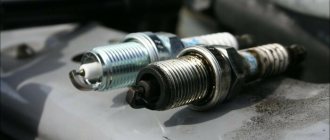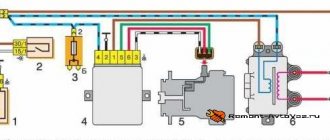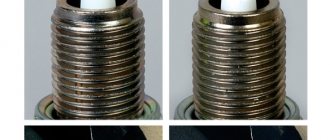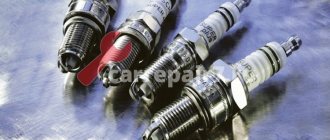The information was taken from here for the safety of this experiment. One year and a half ago, when replacing spark plugs, I noticed the fact that although the condition of all the removed spark plugs was decent, a couple of them had a darker thread color (as if slightly sooty) in relation to the thread color of a couple of others spark plugs, although the electrodes themselves were normal and the insulator itself around the central electrode had an acceptable color, which indicated the normal condition of the engine and good fuel, despite the fact that the spark plugs had traveled a little over 25,000 km.
However, this fact prompted me to think that this difference may be somehow related to the difference in the operation of the cylinders themselves (CPG), not the same combustion of the fuel mixture in the cylinders, for example, due to the difference in the compression values in the cylinders, the difference in the performance of the injectors... , yet the mileage by that time was almost 300,000 km). Geshik, however, never caused any grief during the period of operation and still behaves with dignity. However, it was then that I decided to analyze this fact in more detail. First of all, I want to say that the recommended engine oil SHELL HELIX ULTRA 5W-40 is poured into the engine from the first day of operation and the oil consumption for waste is no more than 200-300 g for a mileage of 10-12 thousand km (I change the oil in this mileage interval), that’s all consumables (filters, fluids, oils...) and spark plugs, including only those recommended and original from NGK. I wondered what the real reason was that the threads of a pair of spark plugs removed from the cylinders had a darker shade. First of all, I decided to check the main thing for myself - the compression values for each cylinder. It didn’t take long to wait and the result turned out to be in the “pots” from 14.5 to 14.8. The measurement was carried out several times in order to obtain a result close to the truth. This was taken into account and the possibility of a difference in the color of the threads of a pair of spark plugs due to a possible difference in compression in the cylinders was immediately excluded, since it would be clear that with lower compression a certain amount of oil could enter the combustion chamber, which could be the difference in the color of the carving of the candles. But the fact that the compression was normal and there was still no oil burn at this point was rejected by me. Actually, what began to happen next, my observations, led me to some conclusions, which ultimately allowed me to achieve a reduction in fuel consumption! But first I needed to figure out the reason for this difference in the color of the candle threads.
So, now everything is in order.
Having the results of compression measurements in hand (they, as you know, were normal), I decided to at least subjectively attribute the difference in the color of the spark plug threads to the difference in the performance of the injectors. That is, if the injector, for example, is dirty or “old”, then it can either spray fuel poorly, or pour more fuel into the chamber than required, work unstably, jamming, for example... For this check, the simplest solution was found... I just took it and I marked two spark plugs with “darker” threads, then I simply cleaned all 4 spark plugs to a “new” state and screwed the marked spark plugs with dark threads into the other two cylinders, and a couple of spark plugs with normal thread color into those cylinders, where were the “dark” candles turned out from! I drove this way for about 5-7 thousand km and decided to check the condition of the spark plugs. Having unscrewed the candles, I noticed that the marked candles again began to have darker threads! Interesting...I thought?! And then “Ostapa”, that is, I got carried away. ) Thoughts ran in their bustle, every now and then, resting on the inside of the skull! I didn't give them any chance to escape. The skull began to warm up slightly. ))) What I thought about at the very beginning, having seen all this and having some little experience of “communicating” with cars, these were the eternal questions not only “What to do?” and “What should I do?”, but a new one also emerged. “What the hell?!”...It turns out that the fuel here doesn’t burn as well as it should? That is, what I had at this moment. This is because the compression was normal and the color of the thread was different in no way because of this; then, the injectors are in order, otherwise the picture on the “clean” unmarked spark plugs should have been consistent.
At this moment, somewhere from within, the professional instinct of an electronics engineer, just a person who has experience working with electricity and wires, kicked in... I quietly, so as not to scare the thought that came to me, take a tester (multimeter) and stupidly begin to measure the resistance of all the unscrewed spark plugs, having previously cleaned the contacts candles (the upper one, the one for the high voltage wires and the central electrode) I measure the resistance between them ... my eyes receive information and I feel that the soap in my skull is beginning an even more intense chaotic Brownian movement, clearly anticipating some clue to the external state of the candles (the different color of the candle threads ...).And all this simply begins to “wind up” thoughts even further and further, since events take place to be developed further... and there a very interesting picture emerges in the future.
I won’t bore anyone, but I’ll just say this... The candles that were initially marked, those that had a darker thread color, had a higher ohmic resistance in relation to other candles. The picture had the following layout... candles with normal thread color had a resistance of 3.5 kOhm and 3.7 kOhm..., and those marked and cleaned before testing, which again after the run began to have a dark thread color, had a resistance of 7.1 and 6.9 kOhm. It seems that everything has become clear! I thought a little. What causes the difference? Consequences of using spark plugs or is this a factory variation in the resistances of the four spark plugs? To do this, we had to check everything first. Since I have long mileage and I change spark plugs every 25-30 thousand km, naturally I don’t literally throw all the spark plugs into the trash. I give some to friends, and leave some for myself as an emergency option if something suddenly happens on the road! In general, after rummaging around the bottom of the barrel, I picked out 4 used sets of candles.
There were experiments to be done. I just wanted to tinker the hell out of my idea! After all, this idea began to exist quite by accident a year and a half ago at the time of a simple replacement of spark plugs! Naturally, I wanted to find and collect as many used candles as possible and analyze everything that was noted above. All found spark plugs were measured for ohmic resistance values, marked, and almost all spark plugs with darker threads to one degree or another had a higher ohmic resistance when the electrodes were in normal condition. The fact that not all spark plugs with high ohmic resistance had a darker color also made me think. All used spark plugs were cleaned to a shine, almost to “new” condition. And then the “game with candles” experiments began. Having first selected and installed one spark plug with a higher resistance in relation to the others, after some mileage the picture was similar to the first one. This spark plug “darkened”, which made me think, if so, then the fuel does not burn completely, not efficiently, which means they will losses in engine power and efficiency! Then I cleaned the same spark plug and installed another one with a higher resistance in relation to the other two (the difference is about 2 times)…
The effect was predictable. The same. Then I went further and decided to “make fun” of the idea, I began to pervert it, installing all sorts of candle options (playing with the selection of resistances)! Naturally, I recorded all this and made notes to myself...with what resistance and in which cylinder the spark plugs were installed. And imagine my surprise when all the selected candles with high resistance ended up being dark! I thought about the impact of all these “dances” of spark plug arrangements on fuel consumption and, accordingly, on the operation (efficiency) of the engine itself! Naturally, all this should have been reflected in the starting of the engine, its operation at idle speed and acceleration dynamics, and, consequently, on fuel consumption! . I’ll immediately make a reservation that all the spark plugs were of the same type and the spark plug gap was strictly controlled and was equal to 1.0 mm everywhere. After all these “games” with candles, a specific picture emerged. Fuel consumption will definitely depend on the correct selection of spark plugs (based on resistance)?!
Features of the functioning of the ignition system
- One basic physical principle has been introduced into the ignition system, which allows us to understand how spark plugs affect fuel consumption. Let us recall that in the process of operation of the entire system, electrical energy is converted into that very movable energy - thermal. This process starts due to the resulting discharge between the electrodes in the spark plugs.
- According to technical documents, it is known that for normal operation of the engine and combustion of the working mixture in the cylinders, an electrical discharge voltage of at least 10 kV is required. And with an increase in this number, the gap between the sparks of the electrodes increases. It cannot be said that this has a positive effect on the ignition system; all devices and components are under load, and the car owner calculates the cost of gasoline, increasing the number of refills. Here is the first answer to how spark plugs affect gasoline consumption and why there are malfunctions in the system.
- It is believed that not only the power of the electric charge, but also the time intervals between ignition of the working mixture are of great importance. They practically affect the operation of the engine, its starting and maneuvering features. The optimal operating option is manifested in the interaction of several components and even technical parameters are indicated. Let us remind you that at the moment of ignition of a special air-fuel mixture, the pressure in the system reaches its maximum. And when the piston passes top dead center, it is at an angle of 10 degrees to the angle of rotation of the crankshaft. And only if all technical parameters coincide, we can say that the engine runs smoothly, and there is no need to think about how spark plugs affect fuel consumption.
- There is a proportional relationship between the ignition moment of the working air-fuel mixture, as well as the combustion rate and the speed characteristics of the engine.
Ignition system
Thus, the operation of the internal combustion engine is associated with peculiarities, as well as the consistency of the operation of all components of the ignition system. All the subtleties of operation are difficult to take into account and understand, but if the ignition system malfunctions inside, it provokes a disruption in the operation of other systems, which means that the question of how spark plugs affect gasoline consumption becomes relevant, and whether something can be changed.
How do spark plugs affect fuel consumption?
The operation of vehicle mechanisms depends on many components. And the driver is not always interested in tuning, the “stuffing” of the car’s interior; many people wonder how much it will cost to maintain the car. Presumably, the owner estimates the costs of repairs, technical inspections, as well as refueling. And if there is an overspending of finances, then the desire to understand how spark plugs affect gasoline consumption is immediately revived. And we can voice some of the reasons for the financial losses of the owner of the “glutton” car.
- Bad gasoline. The main reason for overspending of a car owner's money. If you want to save on the quality of fuel, then you will lose on the quantity of gasoline purchased. If you think about how spark plugs affect fuel consumption, you can remember what the mixture is formed from in the cylinders. And the combustion rate of the working air-fuel mixture also depends on the composition and homogeneity of gasoline, the degree of compression and other factors affecting mixture formation.
- Condition of the candle. The main components of the spark plug - the central electrode, the insulator with the housing, and the ground electrode - must be in good working order and undamaged. After all, a spark jumps between the central electrode and the ground electrode, which ignites the working mixture. If the spark plug is new and in good working order, then the engine starts without problems, and its operation at idle and at maximum speeds does not suffer.
Wrong choice of spark plugs and ride quality
If the spark plugs are chosen incorrectly, this can lead to a significant loss of vehicle power. In addition, after a short amount of time, your engine will begin to work unstably, “triple” and even turn off spontaneously. The spark plugs may not produce the necessary spark; they will be flooded with gasoline, which will cause the engine to stop completely and fail when you try to turn it on.
Do not forget that installing a spark plug of the wrong length can cause damage to the engine piston if its length is much longer than that specified in the vehicle documentation.
Advice for car enthusiasts on fuel consumption
- It is not recommended to frequently change the brand of gasoline or supplier. The condition of the working mixture, and how susceptible it can be to combustion and the release of thermal energy, depends on your constancy and devotion to the gas station.
- Monitor the external condition of the spark plugs; they should not be damaged or covered with soot, otherwise you will have to think about how the spark plugs affect gasoline consumption. It should be remembered that after starting the engine, the tip of the spark plug insulator must warm up to the self-cleaning temperature, which is approximately 400-500 degrees Celsius. If the condition is met, then carbon deposits do not form on the spark plug body, which means that the machine works well and confidently.
- We remind you that if you often travel at low speeds, for example, in traffic jams, this leads to more intense carbon formation, and this leads to increased financial costs, and the question of how spark plugs affect gasoline consumption comes up more and more often.
Vehicle fuel consumption when driving
Thus, if you keep your car in good condition, check the ignition system, and periodically change spark plugs, you can save on refueling by spending money on more valuable things. It is worth following all the rules for operating a vehicle and carrying out technical inspections in order to decide in time how spark plugs affect gasoline consumption.
And if you have a recipe for saving gasoline and can prove that spark plugs affect fuel consumption, then write to us and we will discuss all your opinions.
The goal of our joint work is to help car enthusiasts who are trying to solve the problems of their steel horse on their own.
We are waiting for your advice and ideas!
Summary: [show]
Unstable operation of the spark plugs immediately affects the ignition of the mixture in the cylinders, and not completely burned fuel simply flies out into the exhaust system, thereby disabling the catalytic converter. In this case, the first thing we will see is increased fuel consumption. The exhaust system oxygen sensor reads and transmits information to a computer, which analyzes the data and compares it with information from the mass air flow sensor.
What is an internal combustion engine? And how versatile is it? It turns out that starting the engine is complicated by the “cold” temperature regime, which makes it difficult to form high-quality and consistent mixtures, as well as reliable and rapid ignition, the necessary and absolute combustion of the air-fuel mixture. Understanding the principles of engine operation, it is very easy to understand how spark plugs affect gasoline consumption, and whether it is possible to influence this, trying to reduce spending on the family budget.
Features of the functioning of the ignition system
One basic physical principle has been introduced into the ignition system, which allows us to understand how spark plugs affect fuel consumption. Let us recall that in the process of operation of the entire system, electrical energy is converted into that very movable energy - thermal. This process starts due to the resulting discharge between the electrodes in the spark plugs.
According to technical documents, it is known that for normal operation of the engine and combustion of the working mixture in the cylinders, an electrical discharge voltage of at least 10 kV is required. And with an increase in this number, the gap between the sparks of the electrodes increases. It cannot be said that this has a positive effect on the ignition system; all devices and components are under load, and the car owner calculates the cost of gasoline, increasing the number of refills. Here is the first answer to how spark plugs affect gasoline consumption and why there are malfunctions in the system.
It is believed that not only the power of the electric charge, but also the time intervals between ignition of the working mixture are of great importance. They practically affect the operation of the engine, its starting and maneuvering features. The optimal operating option is manifested in the interaction of several components and even technical parameters are indicated.
Let us remind you that at the moment of ignition of a special air-fuel mixture, the pressure in the system reaches its maximum. And when the piston passes top dead center, it is at an angle of 10 degrees to the angle of rotation of the crankshaft. And only if all technical parameters coincide, we can say that the engine runs smoothly, and there is no need to think about how spark plugs affect fuel consumption.
There is a proportional relationship between the ignition moment of the working air-fuel mixture, as well as the combustion rate and the speed characteristics of the engine.
How do spark plugs affect fuel consumption?
The operation of vehicle mechanisms depends on many components. And the driver is not always interested in tuning, the “stuffing” of the car’s interior; many people wonder how much it will cost to maintain the car. Presumably, the owner estimates the costs of repairs, technical inspections, as well as refueling. And if there is an overspending of finances, then the desire to understand how spark plugs affect gasoline consumption is immediately revived. And we can voice some of the reasons for the financial losses of the owner of the “glutton” car.
Bad gasoline. The main reason for overspending of a car owner's money. If you want to save on the quality of fuel, then you will lose on the quantity of gasoline purchased. If you think about how spark plugs affect fuel consumption, you can remember what the mixture is formed from in the cylinders. And the combustion rate of the working air-fuel mixture also depends on the composition and homogeneity of gasoline, the degree of compression and other factors affecting mixture formation.
Condition of the candle. The main components of the spark plug - the central electrode, the insulator with the housing, and the ground electrode - must be in good working order and undamaged. After all, a spark jumps between the central electrode and the ground electrode, which ignites the working mixture. If the spark plug is new and in good working order, then the engine starts without problems, and its operation at idle and at maximum speeds does not suffer.
Features of spark plugs
- The temperature of the central electrode of the spark plug reaches 850 degrees Celsius.
- Electrode material is chromium steel wire or nickel-manganese.
- The product has high temperature resistance and a low expansion coefficient.
- The gap between the electrodes according to the standard is 0.5-0.9 mm.
- The performance of a candle depends on its thermal state.
Spark plug
Thus, in the design features of the product, you can find some features to understand how spark plugs affect gasoline consumption, and whether this can be corrected.
Spark plugs made of iridium and platinum - the better
Traditional electrode spark plugs have long been the only alternative in internal combustion engines. However, recently other products have appeared on the market that have improved characteristics. Take, for example, platinum candles - more expensive, but strong, equipped with several electrodes, which can be located in the center or on the sides.
The name itself suggests that they use precious metal from which a special surfacing is made. Or platinum is used to create an electrode - and as a result it becomes less susceptible to chemical damage or corrosion than the usual alloy of chromium and nickel.
Another interesting and popular solution could be iridium spark plugs. They have such a thin electrode that its thickness does not exceed 0.4 mm. Thanks to this, less carbon deposits accumulate and the service life increases. In addition to extended mileage, manufacturers promise savings in fuel consumption and ease of starting the engine.
It is necessary to choose the right spark plug based on the recommendations of the car manufacturer. They are contained in the instructions for the vehicle. Be sure to take into account such a criterion as the “heat number”, which should be as close as possible to the original spark plugs. In addition, the thermal characteristics of this product are assessed, which directly affect both engine power and fuel consumption.
This brings our discussion today to its logical conclusion. However, many useful articles and materials await us ahead. Stay with us to receive new information regularly. In the meantime - see you again!
Sincerely, blog author Andrey Kulpanov
Place for contest advertising
Author:Admin
Advice for car enthusiasts on fuel consumption
It is not recommended to frequently change the brand of gasoline or supplier. The condition of the working mixture, and how susceptible it can be to combustion and the release of thermal energy, depends on your constancy and devotion to the gas station.
Monitor the external condition of the spark plugs; they should not be damaged or covered with soot, otherwise you will have to think about how the spark plugs affect gasoline consumption. It should be remembered that after starting the engine, the tip of the spark plug insulator must warm up to the self-cleaning temperature, which is approximately 400-500 degrees Celsius. If the condition is met, then carbon deposits do not form on the spark plug body, which means that the machine works well and confidently.
We remind you that if you often travel at low speeds, for example, in traffic jams, this leads to more intense carbon formation, and this leads to increased financial costs, and the question of how spark plugs affect gasoline consumption comes up more and more often.
How to check and how to set it
The process is not as complicated as it seems at first glance. To begin with, we simply unscrew the spark plugs, then look for damage; if there is none, then you can first clean it, then check the gap.
Of course, the gap can be measured with conventional measuring instruments, just a ruler. However, it is very difficult to determine 0.5 or 0.7 mm by sight! Therefore, now in stores you can buy so-called sets of “feelers” or special keys for checking the gap.
The probes are similar to metal curved letters “G”, with different sizes; we simply place them between the electrodes and determine the gap with an accuracy of 97%. If it is larger, for example on an injector than 1.1 mm, then the contacts are brought closer to each other, you can simply tap with the handle of a screwdriver. If it’s too close, then we move them apart from each other, again checking with a probe.
Watch my video about the gap.











